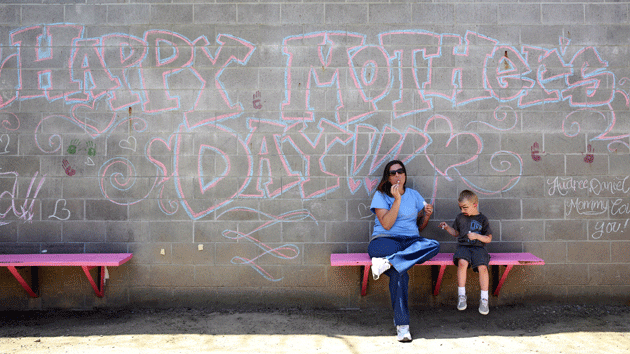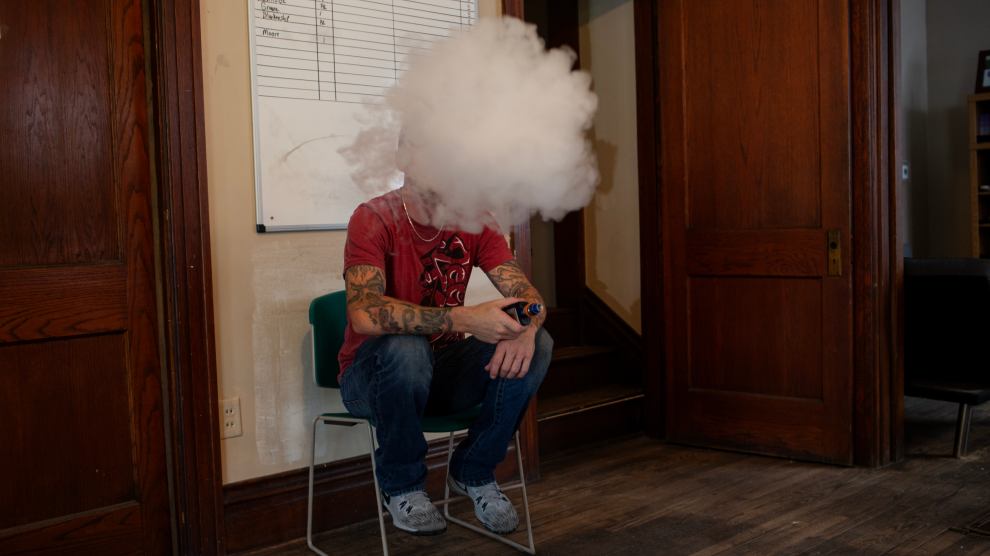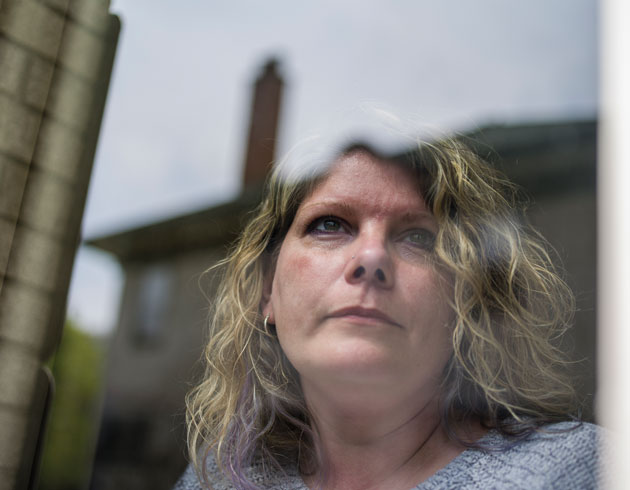
In the early morning hours of June 30, 1995, a fire sparked to life in Kristine Bunch’s mobile home. It fanned out across the floor and climbed up the walls, then formed an impassable barrier across the middle of the trailer. Bunch, 21, snapped awake in the living room. Her three-year-old son, Tony, shrieked for her on the other side of the flames.
Bunch staggered outside and howled for a neighbor. She bashed Tony’s window with a tricycle. As the flames lashed 30 feet into the dawn sky, a fire engine tore up to the house. A firefighter, crawling on his belly, found Tony’s charred body in the bedroom.
Bunch told police she had no idea what caused the fire. Soon, though, arson investigators determined that a liquid accelerant such as kerosene or lighter fluid had been poured in Tony’s bedroom and the living room. Police arrested Bunch on charges of arson and felony murder. Eight months later, Bunch went on trial. By then, she was 22 and unexpectedly pregnant with a second child. The evidence against her seemed overwhelming. Two arson investigators gave compelling testimony for the prosecution, and the jury took only a few hours to convict her on both counts.
At sentencing, Bunch recalled, the judge sneered down at her belly.
“I understand that you have arranged to have yourself impregnated,” he said. “You thought it would work to your advantage somehow in this process. It will not. You will not raise that child.”
The judge gave her the maximum sentence: 60 years.
Karen Daniel and Judy Royal are obsessed with people like Bunch.
During their nearly 30 combined years at the Center on Wrongful Convictions at Northwestern University Law School, the two lawyers have helped exonerate more than two dozen people once found guilty of horrendous crimes. Most of the people they have freed are men; just four are women. And for a long time, Daniel and Royal thought that disparity made perfect sense. Men are convicted of crimes, especially violent crimes, at much higher rates than are women. So it follows that most people exonerated of crimes are also men: The National Registry of Exonerations, a University of Michigan Law School database that has cataloged information on more than 1,600 exonerations nationwide since 1989, includes just 148 women.
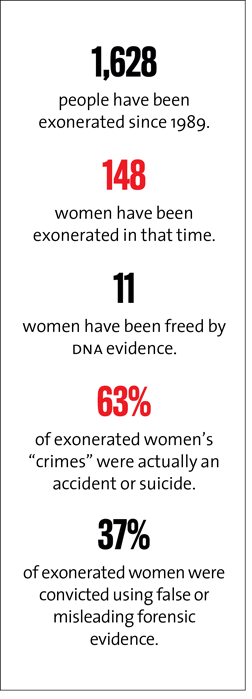
About three years ago, however, Daniel and Royal began to question whether that number was too low. Women make up about 11 percent of the people convicted of violent crimes, but just 6 percent of those exonerated of violent crimes. At the urging of a former client, Julie Rea Harper—who spent four years in prison for the murder of her son before a serial killer confessed to the crime—Daniel and Royal decided to try to figure out if there was anything that set exonerated women apart.
They started by looking at the few women whose cases they had worked on themselves. “I haven’t had any men’s cases that looked like these four cases,” Daniel recalls thinking. “Could that really be a coincidence?”
After three years of pursuing that question, Daniel and Royal have concluded that most innocence projects—including their own legal clinic—are failing to bring justice to wrongly convicted women. They have identified factors that make female clients more difficult to exonerate, and uncovered startling facts that distinguish the cases of wrongly convicted women from those of men. And they have launched a project that could change how the American innocence movement helps these women get justice.
Daniel and Royal started by digging deep into the exonerations database. Their first insight had to do with DNA evidence—the very breakthrough that launched the innocence movement a quarter century ago. “Women tend not to be convicted of the types of crimes that can be overturned based on the results of DNA testing,” Daniel explained. Men perpetrate the overwhelming majority of rapes and murders of strangers. These crimes are much more likely to leave behind DNA evidence that can rule out an innocent suspect, or point to the real rapist or killer.
But when women kill, they usually kill someone close to them. And in most of those cases, DNA isn’t relevant. When a woman is suspected of killing her husband or her child, investigators are likely to find her DNA all over the crime scene whether she’s guilty or innocent—so DNA testing can do little to exonerate her. Sure enough, 27 percent of the men in the exonerations registry were freed using DNA evidence. The same was true of only 7.6 percent of the women.
Yet many exoneration projects, including the original Innocence Project founded in 1992, only work with convicts who can be absolved through DNA. Because courts consider DNA tests definitive and trustworthy, genetic evidence is often the most effective way to overturn a wrongful conviction. Innocence projects have tended to avoid cases in which the offender knew the victim, because it can be hard to disentangle what happened in a domestic crime. In some cases, Daniel said, “you almost have to look into that person’s brain to know what happened.” About half the women in the registry went to prison for harming someone in their care.
But reliance on DNA and aversion to domestic cases weren’t the only hurdles for wrongly convicted women. In a whopping 63 percent of the women’s cases, Daniel and Royal realized, it turned out that there was never a crime to begin with—the death was actually a suicide or an accident. That was true in only 21 percent of the men’s cases.
This was a critical discovery. The tools innocence projects rely on are designed to solve crimes. When DNA evidence isn’t available, innocence investigators may seek to establish alibis, interview witnesses overlooked by police, undermine mistaken witness identifications, or track down alternative suspects with a history of similar crimes. Attorneys have a much easier time getting a wrongful conviction reopened when they can point to the real culprit.
Yet if a woman is wrongly convicted for an accident that kills her child, there is no crime to solve, no “real killer,” and probably no alibi.
Overturning convictions for crimes that were really accidents is difficult and time-consuming. Attorneys may have to prove that the prosecution misused or misunderstood forensic science or withheld crucial evidence. Proving that something was an accident may require attorneys to understand highly technical and controversial evidence on fire science, shaken-baby syndrome, toxicology, or rare medical conditions, and hire expensive expert witnesses to bolster their arguments. These hurdles disproportionately affect women: Daniel and Royal have found that 37 percent of the women (but around 20 percent of the men) in the exonerations registry were cleared because their original convictions used false or misleading forensic evidence.
There was one more thing that set exonerated women apart: Daniel and Royal have come to believe that, in many cases in which women were freed because no crime had been committed, sexist stereotypes had been used to conjure up a motive.
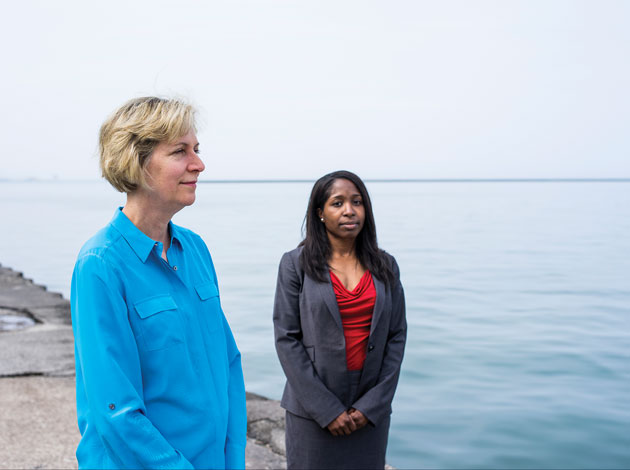
“Almost every case has something like this,” Daniel told me, recounting one trial in which a prosecutor suggested a mother had killed her son so she could pursue a career in modeling. “That was based on one tiny conversation expressing slight interest in maybe having a nice photo taken,” Daniel said. The woman spent years in prison before the real perpetrator came forward.
When Harper, the woman blamed after a serial killer murdered her son, was on trial, the prosecution portrayed her variously as thirsty for revenge on her ex-husband or, pointing out her pursuit of a postgraduate degree, career-obsessed with no time for a child. Her ex-husband testified that Harper considered an abortion when she first became pregnant (which Harper denied). “And that was used to show she was capable of murder,” Royal said, noting that the trial—and jury selection—took place in a rural, heavily conservative county in Illinois.
In the case of Kristine Bunch, the prosecutor said he didn’t think the blaze burned Bunch badly enough. Wouldn’t a mother walk through fire to save her child? He offered evidence that Bunch was a bad mother, telling the jury in his closing argument that she had asked a friend to take custody of Tony, even though the friend had denied this rumor in her testimony. Not to mention the judge’s comments about Bunch’s pregnancy.
These sorts of narratives have “nothing to do with whether the evidence shows that a person did what they’re being accused of,” said Andrea Louise Lewis, an attorney who works for Royal and Daniel. “And these women get wrongfully convicted in these cases where nothing happened. Nothing criminal happened at all.”
After Kristine Bunch gave birth to her second son, correctional officers put her in an ankle chain just long enough for her to reach the toilet in her hospital room. It had been three months since she went to prison. Bunch held her baby for a fleeting moment before her parents took him home with them. Then she made it her single-minded mission to find someone to help reopen her case.
“I realized, I’m going to have to fight,” Bunch recalled. She sent out hundreds of letters and received hundreds of rejections.
While Bunch despaired in prison, new research emerged showing that the signatures of an accidental fire are easy to confuse with signs of arson; as a result, many old arson cases have been called into question. In a similar vein, child abuse investigators once took it as gospel that a baby with brain swelling and certain forms of internal bleeding had been violently shaken within the past several hours. But a new body of evidence suggests that infections, infant strokes, and accidental falls can also cause the telltale symptoms of shaken-baby syndrome (SBS). Meanwhile, child abuse researchers now believe that a symptom like brain bleeding can take days—not hours—to cause serious problems. If a child has several caregivers—a babysitter, relatives, and immediate family members—it can be impossible to say with certainty who abused her.
But it’s prosecutors who decide whether to file charges or fight appeals, and not all of them buy the new science. When I sent questions about wrongly convicted women to the National District Attorneys Association, I was referred to Josh Marquis, an NDAA board member and Oregon district attorney who is a strident skeptic of the innocence community. Daniel and Royal noted that a disproportionate number of women are exonerated because new science cast doubt on their original conviction—or even moved medical experts who once testified against them to change their minds. But Marquis said that he and many of his fellow prosecutors don’t trust the developing science. New doubts about SBS, he said, are shared by only “a very small group of doctors” whose voices have been amplified by the defense bar. As for developments in arson science, he said, “arson investigation is more of an art than a science.”
It was only when Bunch connected with an Indianapolis attorney named Hilary Bowe Ricks, and scraped together a modest fee using her $1.30-a-day prison earnings, that she learned that new arson science could cast her conviction into doubt. In 2006, Ricks convinced the Northwestern center to join the case, and the team, which by then included Daniel, soon found a bevy of problems with the conviction. Bunch’s original defense attorney had argued that one of the trailer home’s many electrical problems probably caused the fire. Any accelerant, he insisted, was likely from a kerosene heater the family sometimes ran in the living room. However, state investigators working on-site (using now-questionable science) observed burn patterns in Tony’s bedroom that fire experts at the time saw as undisputed evidence of arson. And a Bureau of Alcohol, Tobacco, Firearms, and Explosives chemist who examined 10 samples sent to his Washington, DC, lab testified at Bunch’s original trial that the floor of both the living room and the bedroom tested positive for liquid accelerant.
Bunch’s new legal team obtained the raw data that the ATF chemist had analyzed. According to lawsuits her attorneys have since filed against the investigators for withholding evidence, someone had altered the result for the sample in Tony’s bedroom, which was negative for accelerant, making Bunch seem guilty. It appeared to Ricks as though investigators hadn’t found accelerant anywhere in the trailer home, except in the living room, where the heater stood.
The fire that had taken Tony’s life now looked like an accident. (The state investigators have denied any wrongdoing, and an ATF spokeswoman declined to comment.)
Bunch’s legal team brought this undisclosed evidence to the Indiana Court of Appeals. On March 21, 2012, a three-judge panel reversed Bunch’s conviction. The state Supreme Court affirmed the ruling in August, and she walked out of prison, a free woman for the first time in more than 16 years. By Christmas, prosecutors quietly declined to retry her.
A few months after Bunch was released, Daniel and Royal launched Northwestern’s Women’s Project, an exoneration effort focused exclusively on freeing wrongly convicted women. They have already agreed to represent six women—cases that will involve child head trauma and arson science—and in December, they asked the Illinois Supreme Court to grant their first appeal. Meanwhile, their team is poring over files from dozens of suspicious convictions around the country and amassing court transcripts for an in-depth study of wrongful convictions of women accused of killing their children.
Daniel and Royal’s tiny project may wind up in the vanguard of work to exonerate both men and women. More wrongful convictions are overturned each year, but fewer and fewer of them involve DNA: Paul Cates, a spokesman for the Innocence Project, told me that investigators have now cleared many “easy” DNA cases—such as convictions that can be overturned by testing a single previously untested rape kit. Instead, more cases now involve complex DNA evidence, or none at all, and many more of those cases are ultimately found to involve an accident. Last year, a record 125 people were exonerated across the country; in 58 of those cases, courts found no crime was committed at all.
Today, Kristine Bunch volunteers for the Women’s Project, sorting through inmates’ letters. She reads each one carefully, remembering the decade she spent writing pleas just like theirs. “You live with this freaky numbness,” she said. “It’s almost like you’re underwater and everything is in slow motion. And you can’t seem to pull yourself up out of it.”
She is thrilled that there is now an outfit giving convictions like hers its full attention, run by attorneys who understand that everything about a woman—her career, her ambitions, how much she cries—is ripe for judgment. In her off-hours, she is trying to get to know her 19-year-old son. Even though she saw him nearly every weekend in prison, she missed out on raising him, and building a strong relationship has proved difficult.
So has the healing process. Many men who were wrongfully convicted didn’t know their supposed victims. But with Bunch, the accident she was blamed for not only took 17 years of her life—it took her child.
“You’re accused of this horrible, horrible crime, you’re put away, you have newspapers saying horrible, horrible things about you,” she said. “When you walk out, you’re exonerated, and you’re free and clear. But that hurt, that humiliation, that shame—it doesn’t go away because you’ve been exonerated. It’s hard to step back out and act like you’re normal and part of the world.”

